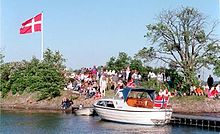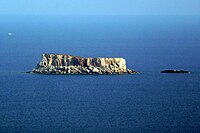Islet

An islet is a very small island. Most definitions are not precise, but some suggest that an islet has little or no vegetation, and cannot support human habitation. They may be made of rock, sand, and/or coral, may be permanent or tidal, and may exist in the sea, rivers or any other body of water.
Definition[edit]
As suggested by its origin as islette, an Old French diminutive of "isle",[1] use of the term implies small size, but little attention is given to drawing an upper limit on its applicability.
The World Landforms website says "An islet landform is generally considered to be a rock or small island that has little vegetation and cannot sustain human habitation", and further that size may vary from a few square feet to several square miles, with no specific rule pertaining to size.[2]
Other terms[edit]

- Ait (/eɪt/, like eight) or eyot (/aɪ(ə)t, eɪt/), a small island. It is especially used to refer to river islands found on the River Thames and its tributaries in England.[3][4][5]
- Cay or key, an islet formed by the accumulation of fine sand deposits atop a reef, especially in the Caribbean and West Atlantic. Rum Cay in the Bahamas and the Florida Keys off Florida are examples of islets.
- The French suffix -hou from the Scandinavian -holm, is used for the names of some islets in the Channel Islands, such as Écréhous, Burhou, Lihou and Les Houmets, and off Normandy, such as Tatihou.
- Inch, a term used especially in Scotland, from the Gaelic innis, which originally meant island, but has been supplanted to refer to smaller islands, such the islet of Inch, off St Mary's Isle Priory, Inch Kenneth, Inchkeith, Keith Inch (no longer an island) and Inchcailloch.[6]
- Motu, a reef islet formed by broken coral and sand, surrounding an atoll, especially in Polynesia,[7] such as Motu One, Motu Nao and Motu Paahi.
- River island, an islet within the current of a river, such as the Île de la Cité in Paris.
- A "rock", in the sense of a type of islet, is an uninhabited landform composed of rock, lying offshore, and having at most minimal vegetation, such as Albino Rock in the Palm Island group off Queensland, Australia.
- Sandbar or shoal, an exposed sandbar.
- Sea stack, a thin, vertical landform jutting out of a body of water.
- Skerry, a small rocky island, usually defined to be too small for habitation, especially in Ireland.
- Subsidiary islets, a more technical application, is applied to small land features isolated by water, lying off the shore of a larger island. Similarly, any emergent land in an atoll is also called an islet.[8]
- Tidal island, small islands (not always islets) which lie off the mainland of an area, being connected to it in low tide and isolated in high tide.
In international law[edit]
Whether an islet is considered a rock or not can have significant economic consequences under Article 121 of the UN Convention on the Law of the Sea, which stipulates that "Rocks which cannot sustain human habitation or economic life of their own shall have no exclusive economic zone or continental shelf." One long-term dispute over the status of such an islet was that of Snake Island (Black Sea).[9][10][11]
The International Court of Justice jurisprudence however sometimes ignores islets, regardless of inhabitation status, in deciding territorial disputes; it did so in 2009 in adjudicating the Romania-Ukraine dispute, and previously in the dispute between Libya and Malta involving the islet of Filfla.[9][12]
List of islets[edit]
There are thousands of islets on Earth: approximately 24,000 islands and islets in the Stockholm archipelago alone. The following is a list of example islets from around the world.
- Águila Islet, the southernmost point of The Americas
- Aplin Islet (Queensland)
- Apia
- Auster Lake Islet
- Ball's Pyramid, South Pacific
- Bay Islet or See Chau, Hong Kong
- Bikirrin, in Majuro, Marshall Islands
- Black Rock, South Atlantic
- Boundary Islet, Australia
- Bogskär, Finland
- Briggs Islet, southeastern Australia
- Bushy Islet (Queensland)
- Capitancillo Islet, in Bogo City, Cebu, Philippines
- Chão, in the Madeira Islands, Portugal
- Cholmondeley Islet (Queensland)
- Clubes Island, Brasília, Brazil
- Columbretes Islands, Spain
- Cone Islet, southeastern Australia
- Douglas Islet (Queensland)
- Dry Tortugas, Florida Keys, USA
- Dugay Islet, southeastern Australia
- Edwards Islet, southeastern Australia
- Enekalamur in Majuro, Marshall Islands
- Enemanit in Majuro, Marshall Islands
- Fairway Rock, Bering Strait
- Fastnet Rock, Ireland
- Filfla, southern Malta
- Formigas, in the Azores islands
- Gáshólmur, Faroe Islands
- Granite Island (South Australia), Victor Harbor, South Australia.
- Galatasaray Islet, Istanbul, Turkey
- Halfway Islet, Queensland, Australia
- Herald Island, Arctic Ocean
- Île Vierge, France
- Isles of Scilly, United Kingdom
- Kid Island, Lake of the Ozarks, Missouri United States
- Islets of Caroline Island, in Kiribati
- Islets of Mauritius
- Isla de Alborán, Spain, Western Mediterranean
- Jardine Islet (Queensland)
- Jethou, Bailiwick of Guernsey
- Keelung Islet, off the northern shore of Taiwan
- Klein Bonaire, Netherlands
- Kolbeinsey, Iceland
- Liancourt Rocks, administered by South Korea, claimed by Japan
- Lihou, Bailiwick of Guernsey
- Magra Islet (Queensland)
- Mañagaha, Saipan
- Martin Islet (New South Wales)
- Mid Woody Islet, southeastern Australia
- Milman Islet (Queensland)
- Monchique Islet, Europe's westernmost point, in the Azores, Portugal
- Noorderhaaks, off the coast of the Netherlands
- Oodaaq, Greenland
- Parece Vela, West Pacific
- Perejil Island, Strait of Gibraltar
- Penguin Islet (Tasmania)
- Pigeon Island, Sri Lanka
- Pokonji Dol, Croatia
- Velika Sestrica, Croatia
- Rockall, North Atlantic
- Saint Peter and Saint Paul rocks, equatorial Atlantic
- Salas y Gómez, Northeast from Easter Island
- Saunders Islet (Queensland)
- Seacrow Islet, southeastern Australia
- Shag Rocks, South Atlantic
- Silver Islet, Ontario
- Sinclair Islet (Queensland)
- Skull Islet, in British Columbia, Canada
- Star Keys/Motuhope, New Zealand
- Saltholm, small Islet in Oresund west of Copenhagen
- Sue Islet (Queensland)
- Sumbiarholmur, Faroe Islands
- Sunday Islet (Queensland)
- Taprobane Island, Sri Lanka
- Thomson Islet (Queensland)
- Tindhólmur, Faroe Islands
- Vilkitsky Island, Arctic Ocean
- Wallace Islet (Queensland)
- Wachusett Reef, Ernest Legouve Reef, and Maria Theresa Reef, South Pacific Ocean
- Westward Islet, in the Pitcairn Islands
- Ynys Lawd, Wales
Notes[edit]
- ^ Webster's New International Dictionary of the English Language, Second Edition, 1958
- ^ "Islet Landforms". World Landforms of the Earth. Retrieved 29 April 2020.
- ^ "Eyot". World Wide Words. 21 June 2003. Retrieved 30 April 2020.
- ^ "Definition of eyot". www.dictionary.com. 20 April 2020. Retrieved 30 April 2020.
- ^ Misachi, John (5 April 2019). "What is an Ait? Ait Defintion". WorldAtlas. Retrieved 30 April 2020.
- ^ Sears, Robert (1847). A New and Popular Pictorial Description of England, Scotland, Ireland, Wales, and the British Islands (6th ed.). R. Sears. pp. 479–481.
Original from University of Iowa, Digitized 9 Mar 2015
- ^ "Motus – What They Are and Why They're Key to the Tahiti Experience". LandLopers. 12 April 2017. Retrieved 30 April 2020.
- ^ "Floristic composition and vegetation classification of the Penghu Southern Four Islands". Marine National Park Headquarters. 18 March 2016. Retrieved 30 April 2020.
- ^ a b Coalter G. Lathrop (July 22, 2009) "Maritime Delimitation in the Black Sea (Romania v. Ukraine)". American Journal of International Law, Vol. 103. SSRN 1470697
- ^ Ukraine, Romania spar over islet, UPI 2006-7-14
- ^ Romania and Ukraine avoid rocky horror show, Euronews, 03/02/09
- ^ Hance D. Smith (1991). The Development of Integrated Sea Use Management. Taylor & Francis. p. 82. ISBN 978-0-415-03816-4.
References[edit]
- Clive Schofield (2012). "Islands or Rocks, Is that the Real Question? The Treatment of Islands in the Delimitation of Maritime Boundaries". In Myron H. Nordquist; John Norton Moore; Alfred H.A. Soons; Hak-So Kim (eds.). The Law of the Sea Convention: US Accession and Globalization. Martinus Nijhoff Publishers. pp. 322–340. ISBN 978-90-04-20136-1.






